Water Beads: 7 Fun Sensory Play Activities for Kids
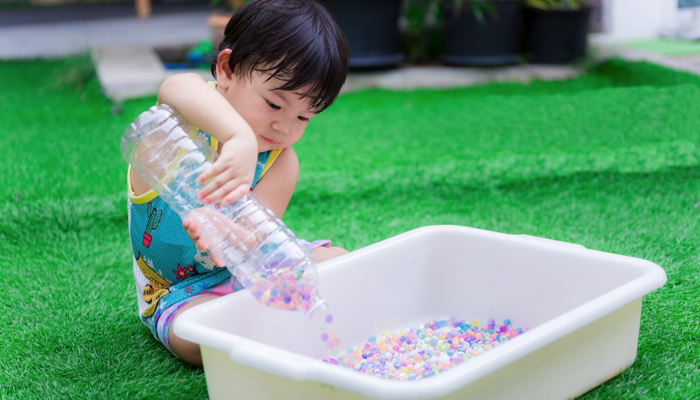
This post may contain affiliate links; please see our terms of use for details.
- If you’ve heard other parents throwing around the terms “jelly beads,” “water orbs,” or “Orbeez,” they’re referring to water beads.
- Young children can acquire many skills from playing with water beads, such as gross and fine motor skills, language development, and social interaction.
- Water beads are easy to prepare. They take several hours to reach their full size, but watching them grow and expand is a fascinating sensory experience all on its own–and a great exercise in teaching patience!
- Water bead sensory exploration is ideal for children 5 years old and above. If you have small children who mouth objects, it’s best to keep them away for now, as water beads pose a choking hazard.
- Water bead activities must always be supervised. Water beads are non-toxic, but they are dangerous for children and pets to ingest.
It’s impossible not to love water beads. Water beads are squishy, bouncy, and oh-so-satisfying to feel and explore.
Counting and sorting, identifying colors, and using hand-eye coordination are only a few of the skills your child will (gladly) learn.
A delightful sensory experience, they come in different sizes and colors. Mix and match, create a theme or throw in some toys. You can let your imagination run wild with water beads.
If an elaborate setup isn’t your thing, your child will still enjoy playing with the water beads on their own. No matter how you decide to set up your activities, water beads are so much fun that your child won’t realize how much she’s learning.
What Are Water Beads?
Water beads consist of just 2 ingredients: water and water-absorbing polymer. They are tiny and hard in texture when dry. They expand up to 100 times their original size when immersed in water while becoming soft and squishy.
Initially created as a method for watering plants in farm fields, people realized additional functional possibilities for these handy little beads.
With clear water beads and colorful ones alike, you can use them for:
- Flower arrangements
- Potted plants and gardening
- Art projects
- Home decor
- Aromatherapy
- Education
- And, of course, sensory play for kids
How to Prepare Water Beads
To prepare water beads, you will need:
- A sensory bin or any large container or tray with edges
- Water
- 1-2 tablespoons of dry water beads
- At least 6 hours before playtime with water beads
Here’s how to prepare water beads:
- Pour the water beads into the container.
- Add water to the beads, adding just enough to cover the bottom of the container.
- Continue to add more water as the beads absorb it.
- Depending on the brand of the water beads, it may take up to 8 hours as the beads absorb water to expand. Extra large beads can take up to 36 hours to expand fully.
Where to Find Water Beads
Water beads are available online and in stores, commonly found at these locations:
You can also find them at your local craft store. Florists use water beads in floral arrangements, so you’ll want to head to the store’s floral department.
7 Water Bead Sensory Activities for Kids
Water bead sensory activities can be as simple as placing the water beads in a large container and allowing your child to explore them.
Throw in some sensory toys, such as cups, scoops, and funnels, and there you have it: hours of entertainment!
There are so many creative ways to provide water bead sensory activities for your kids, from adding them to water balloons, throwing them in a kiddie pool, making them part of a water table activity, or even adding food coloring to clear beads. Below are our top favorite ways to play with water beads.
1. Frozen Water Beads
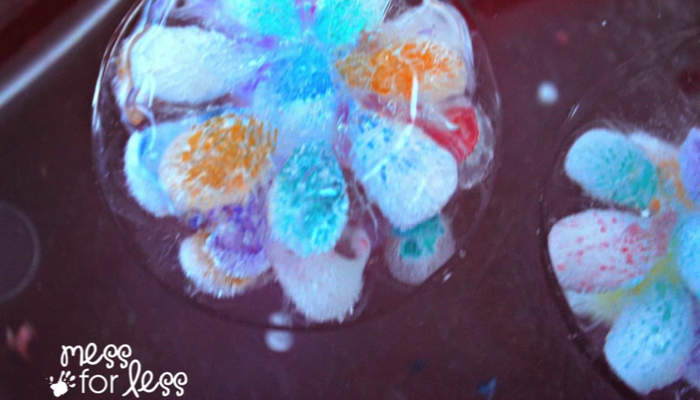
Perfect as a hot day activity, your child can keep cool while having fun with frozen water beads.
Vicky of Mess for Less let curiosity take the lead. She wondered what would happen if she froze the water beads. Throughout the process, Vicky encouraged her child to engage all her senses.
First, place already-grown water beads into empty plastic applesauce or fruit cups. Cover the beads with water.
Next, freeze the cups overnight. Then, pop out the frozen water beads into a bin filled with water.
Step back, and allow your child to observe and explore. As Vicky did, you can let your child chip away at the frozen water beads with a fork. As the ice melts away, ask how the beads feel and smell.
Don’t be surprised if she remains engaged in this activity for a few hours!
2. Giant Water Beads
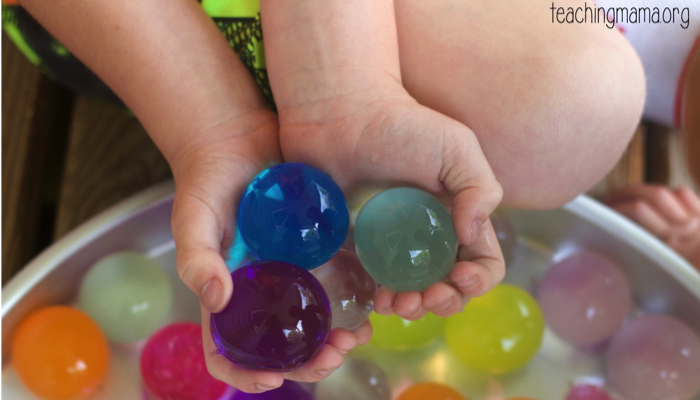
As in the case with small water beads, preparation is simple. Cover the giant water beads with water and wait. Allow 30 hours for them to grow to their full size.
Angela from Teaching Mama points out the educational uses of giant water beads through sensory play. By playing with giant water beads, children can:
- Learn color recognition: Have your child name all the colors of the water beads.
- Experiment with cause and effect: Let wonderment lead the activity. You can initiate by saying, “I wonder what will happen if you drop one on the floor.” Your child will most likely catch on and come up with her own experiments pretty quickly!
- Increase sensory processing skills: Your child will learn the meaning of “squishy” by playing with giant water beads. Just a little warning: giant water beads are more fragile and easier to crush than small beads!
- Develop social skills: If your child is playing with other children or a sibling, they’re inevitably going to want the same water bead. Encourage them to agree with taking turns and sharing.
3. Water Beads on a Light Table
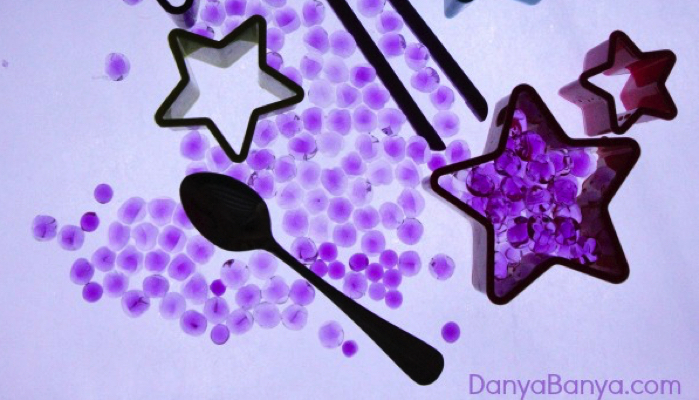
Just one of many great sensory table ideas, this activity is perfect for your budding scientist. You might also want to keep this activity in your pocket for a rainy day.
Danya of Danya Banya used her DIY light table to introduce her kids to the wonder of science. Based on her observations of the growth process of water beads, she conducted an experiment.
Unlike watching paint dry, watching water beads grow can be fascinating. As the water beads absorbed water, Danya and her girls noticed that they took on different forms.
Here’s what you’ll need for this activity:
- A light table
- Several cookie cutters
- Dry water beads
- A jar or a vase, or any transparent vessel that will allow you to see the growing water beads
Follow these steps to experiment:
- Place the cookie cutters on top of a lit light table.
- Pour dry water beads into a clear jar, and add just enough water to cover them.
- Watch the beads become very bumpy within the first minute of immersing the water beads in the water. Remove a few of the water beads. Place them in a cookie-cutter and observe their shape and texture.
- During the next minute, watch the beads become lumpy. Remove a few at this stage and place them into another cookie cutter.
- Check back in every couple of hours and observe the water beads. In each phase, remove a few water beads and place them in a separate cookie cutter.
4. Water Beads and Essential Oils
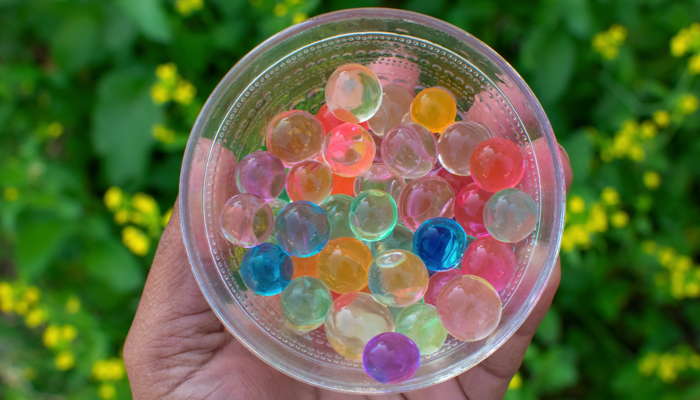
You can make water beads a stimulating activity and a calming one. Tinker with different scents and engage your child’s senses.
Samantha of Samantha McCracken uses essential oils to create some fun and relaxation for her son with ASD.
You can set up this activity in a special room or designated space where your child can experience the full sensory effect.
Here’s what you’ll need for this activity:
- Water beads that are already fully expanded
- A sensory bin (Samantha used a Pyrex baking dish)
- Small toys
- Carrier oil (such as coconut oil)
- Lavender or vetiver essential oil
- A bath mat or towel to place under the bin
Here are the steps to invite your child to this calming activity:
- Place the water beads and toys into a sensory bin.
- Add one teaspoon of carrier oil.
- Add 8 drops of essential oil.
5. Water Beads and Shaving Cream
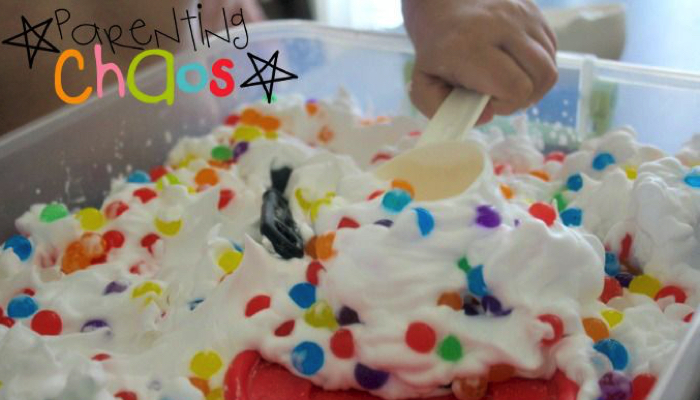
You can use shaving cream to add an exciting and fun textural element to water beads.
Stephanie of Parenting Chaos set up this activity for her kids and had just enough time to finish cleaning her kitchen.
Here’s what you’ll need:
- Water beads that are already fully expanded
- A can of shaving cream
- A container
- Toys, such as scoops and cups
Follow these steps to set up this activity:
- Spray shaving cream into a container.
- Have your child sprinkle the water beads on top, adding however much she pleases.
- Provide sensory toys
6. Glow-in-the-dark Water Bead Sensory Bottle
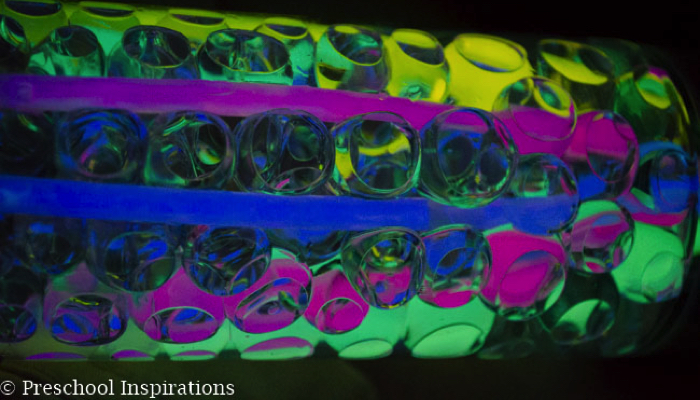
Katie of Preschool Inspirations made her sensory toy using materials that you can find at a dollar store. Her child even used it as a night light because the glow sticks lasted so long.
The great thing about this activity is that younger children can play with it because the bottle will contain the water beads. Supervision, though, is always recommended.
Here’s what you’ll need:
- An empty water bottle
- Glow sticks
- Clear water beads
Take these steps to create this very cool sensory bottle:
- Prepare water beads.
- Pour the water beads into an empty water bottle. Leave enough space at the top to fit the glow sticks.
- Activate the glow sticks and slide them into the bottle.
- Bring the bottle to a dark space and prepare for the “oohs” and “aahs.”
7. Paint with Water Beads
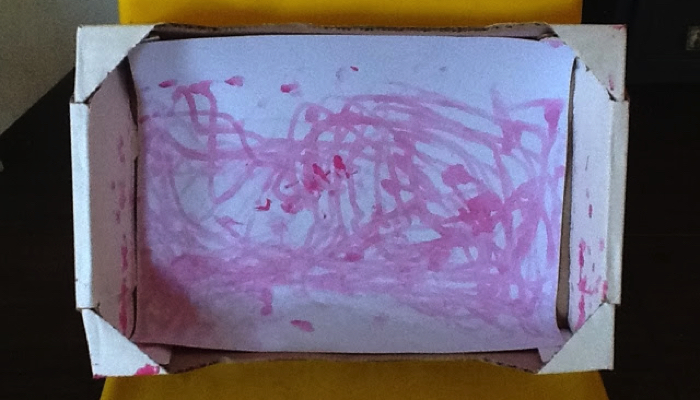
This activity is for all the artistic souls out there. Nadia of Teach Me Mommy set up this art activity using simple items around the house.
Here’s what you’ll need:
- Bottles of paint
- A handful of water beads that are already fully expanded
- A cardboard box small enough for your child to hold and tilt easily
- Paper (to paint on) cut to fit inside the cardboard box
Follow these steps to unleash your child’s inner artist:
- Cut paper to fit into the cardboard box.
- Pour paint onto the paper inside the box.
- Add a few water beads.
- Encourage your child to tilt the box and move the beads around. The beads will pick up the paint and make interesting patterns.
FAQs
How Long Do Water Beads Last?
Water beads can last up to 2 years and possibly longer if stored properly.
The best way to store water beads is to place them in a Ziploc bag or a container with an airtight lid. The key is to dehydrate them entirely first.
How Do You Dispose of Water Beads?
When you’re ready to dispose of water beads, crumble them up and place them in your garden soil.
Avoid disposing of them down the sink. The water beads may continue expanding in the pipes and clog the drain. With this in mind, it’s not a good idea to play with water beads as a bathing activity.
Keep in mind that water beads can form mold. If this happens, dispose of them in the trash receptacle.
Can You Reuse Water Beads?
You can reuse water beads several times if they’re not crushed. Crushed water beads can not be reused.
Are Water Beads Safe for Kids?
Water beads are non-toxic and safe for kids 5 years and older, but may pose a choking hazard for kids younger than 5.
The colors and texture are very similar to candy, and many younger kids won’t be able to tell the difference. If anyone ingests water beads, they can continue to expand inside the body and cause gastrointestinal issues.
If you suspect that water beads have been swallowed, watch for these signs:
- Swelling of the stomach
- Refusal to eat
- Drooling
- Wheezing
- Vomiting
- Constipation
If you’d like your younger kids to enjoy the sensory play activities that water beads provide, there are safer alternatives: 1) Tapioca pearls or 2) Water beads sealed in a ziplock bag.
You can tape the plastic bag filled with water beads to a window where it can even act as a pretty suncatcher. Your child can also push around the beads inside the bag without fear of any beads becoming ingested.
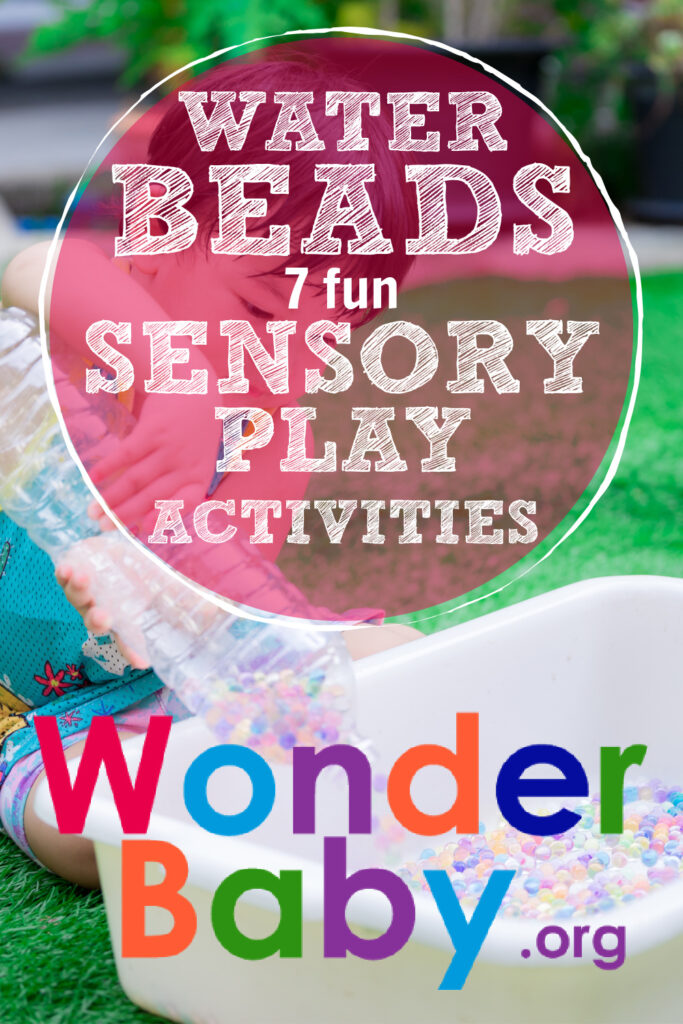
Related Posts
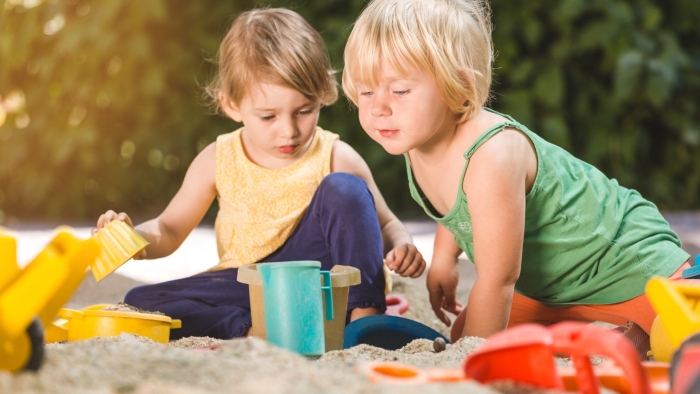
Sensory Activities
5 Sand Play Activities to Encourage Fine Motor Development
Sensory bin, at the beach, or in a sandpit? Try these sand play activities to help toddlers and preschoolers develop their fine motor skills.
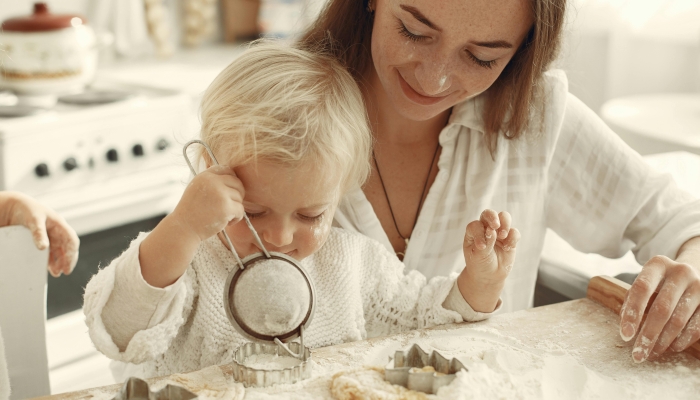
Sensory Activities
5 Edible Sensory Play Ideas
Check out our favorite edible sensory play activities to engage children's senses, boost their development, and provide hours of fun.
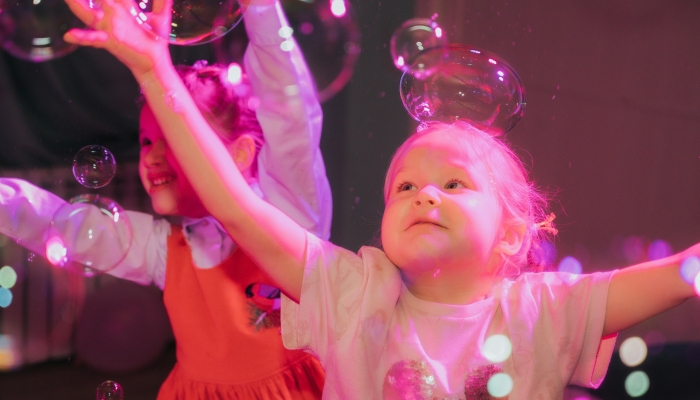
Sensory Activities
How to Make Unpoppable Bubbles
Discover the secret to making unpoppable bubbles with this easy guide. You only need three ingredients!